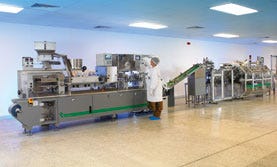March 11, 2015

Oxoid, a member company of Fisher Scientific Intl., faced a rather complicated packaging project with its dispenser cartridges containing antimicrobial susceptibility testing (AST) discs. Oxoid's products are used in clinical and industrial laboratories to isolate and identify the bacteria or other organisms causing disease or spoilage. One of the leading manufacturers and distributors of microbiological culture media and other diagnostic products, the company makes the discs for in-vitro use by laboratories to determine the most appropriate antibiotic and dosage level for infections. Since the firm exports its products all over the world, it must comply with the different regulatory requirements in the many markets it serves, and so provides product information in 10 languages. To boost productivity and accomplish the task successfully, the company recently installed a packaging line incorporating a Romaco (www.romaco.com) Noack Model 623 blister-packing machine and a Promatic Model P100 cartoner.
Installed at Oxoid's headquarters and production site in Basingstoke, Hampshire, in the U.K., the line packs the dispenser cartridges containing multiple AST discs with the help of the two systems, which interface with ancillary equipment, including a specialized feeder from Britain's Electro-Mec (aspnet.electro-mec-reading.ltd.uk) and a Polyphem blister-inspection system from Germany's Laetus (www.laetus.com), both of which were furnished through Romaco in a turnkey capacity.

The Basingstoke plant is the company's main production and administrative site, supported by wholly owned sales and distribution companies in Europe, the Americas, Asia and beyond.
The Basingstoke location is the company's main production and administrative site, supported by a network of wholly owned sales and distribution companies located in Europe, North and South America, Asia and Australia.
Also made in the Basingstoke plant, each of the AST discs is impregnated with a specific amount of antibiotic and is contained in specially designed, spring-loaded cartridges that hold 50 discs. Measuring about 8 cm long, each cartridge is then delivered to the packaging area for final packoff.
According to Oxoid, the new line is helping to jumpstart output through higher levels of automation, as the blister machine and cartoner replace older equipment. The Noack system has an extended feeding channel to accommodate two cartridge depositors from Romaco that were designed especially to accommodate Oxoid's products. These feeding channels operate in tandem to ensure a high degree of autonomy. As one depositor empties, the feed switches to the other depositor for a continuous flow of product. Complete elimination of moisture is essential for correct operation of the cartridges, so each blister pocket also contains a dessicant tablet fed by means of the Electro-Mec feeding unit installed alongside the cartridge depositors.
The project has been running smoothly at every stage, from specification to installation and commissioning.
Ninety-nine percent of Oxoid's AST disc production goes into packs containing five cartridges. These are loaded into a single blister with perforations between blisters. The cartridges have overall dimensions of 145x125 mm and a forming depth of 10 mm. Accuracy of sealing, perforation and punching is a must and is guaranteed by laser-detection devices and an integral waste foil shredder, which reduces operator intervention time. The blister-packer's outfeed conveyor also has reject stations that automatically segregate any empty blisters and those that might be partially filled.
Since all of the cartridges have the same dimensions, there's no need for size changeparts on the blister machine. The only variable is that Oxoid occasionally produces a package containing a single cartridge. This is handled by a special arrangement of punching tools that again minimize changeover requirements.

Higher throughputs are a benefit of the new, speedier equipment and electronic controls.
In production at the Basingstoke plant, blisters that are verified as being correct are conveyed directly to the infeed of the Promatic P100 cartoning machine. Because of the company's multilingual packaging copy requirements, Oxoid added booklet and leaflet feeder systems to the cartoner to ensure insertion of this information into each of the cartons.
Project manager Carl Smith says that the Romaco equipment is definitely living up to Oxoid's expectations. Romaco was the frontrunner throughout the project, he indicates.
"Our starting point was the blister-packer—we produce at least 35,000 packs per day," he notes.
"The Noack 623's reputation as a compact, user-friendly and reliable machine is beyond question," Smith says. "We are certainly seeing higher throughput, thanks to the electronic control devices on the line and to the reliability and ease of operation of the Noack and Promatic machines.
"We also managed to reduce operator intervention time to just ten minutes and minimized our staffing levels on the packaging line, which we believe is a significant improvement."
We're seeing higher throughput, thanks to the electronic control devices and the operating ease of the machines.
Moreover, Smith continues, "the blisters have a much higher quality appearance and less deformation, thanks to the Noack's 520-millimeter heating area, which allows for controlled heating of the web."
Smith goes on to say that an important factor in the choice of the cartoner was its ability to guarantee the opening of each and every carton. "Our cartons have some very small dimensions relative to the size of the blister, which we identified as potentially problematic when moving to the replacement machinery," he notes. "But this concern has been completely eliminated by the cartoner's double-positive opening system. The machine hasn't missed a beat since installation."
Although Oxoid has considered several other suppliers, Smith relates that Romaco's approach was the one that engendered real confidence. "The project has been running extremely smoothly at every stage, from specification right through to installation and commissioning," he sums up. And that's a happy ending for an unusual packaging application serving a vital healthcare product.
More information is available:
Romaco USA, 973/709-0691. www.romaco.com.
Electro-Mec, 44 0 118 958 2035. aspnet.electro-mec-reading.ltd.uk.
Laetus GmbH, 49 0 6257 5009 0. www.laetus.com.
About the Author(s)
You May Also Like


